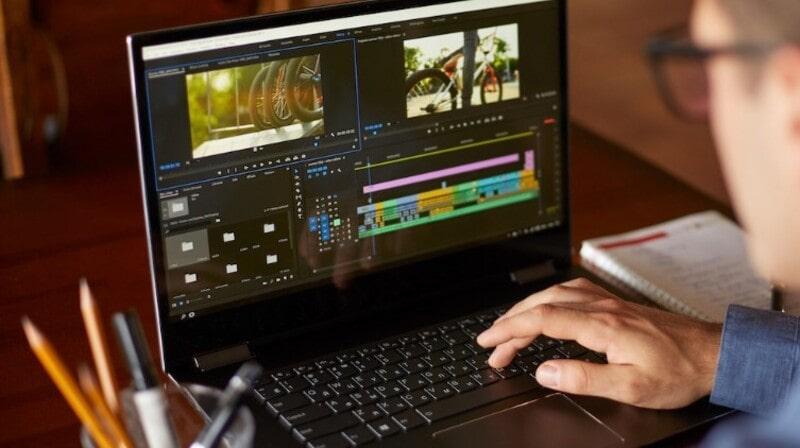
In the film industry, video transition effects are one of the decisive factors that help increase the attractiveness and professionalism of the work. Right now, let's explore the most commonly used transition effects with Viewfinder Media.
1. What is video transition?
Video transition is a technique that plays an extremely important role in the photo editing process. This is simply understood as a transition effect between two different scenes. This effect helps indicate a change in plot development, moving to a different location, or showing the passage of time. It can also simply be a way to move the audience from the current scene to the next in a smoother and more professional way.
Learn what the concept of video transitions is
From movies to music videos or media advertisements, transition effects are used flexibly and diversely. This helps create appeal and inspiration for viewers.
>>>> CLICK HERE: What is a gaffer? What does this position do in the film crew?
2. Popular video transition effects
Some popular video transition effects today include:
2.1. Standard cut
This is the simplest effect among video transitions. The process of using this effect also does not require the use of many specialized skills. It simply combines two clips together to show continuity and describe the progression of the action. The operation is simply by placing the last detail of the previous clip next to the first detail of the following clip and it's complete.
How to transition scenes in video using the Standard cut effect
2.2. Jump cut
Jump cut is briefly understood as a jump scene. It is a subdivision of a large scene. Instead of showing a long clip seamlessly, you will cut it into many different small segments and then combine them. This will help create a jumping effect, bringing a feeling of rush to viewers when enjoying the movies.
How to transition scenes in a video using the Jump cut effect
>>>> DON'T MISS OUT: What is VFX? VFX techniques revealed
2.3. Montage
Montage video transition effects are made using a sequence of existing videos to stitch together. This effect helps highlight the character's actions. It could be a change in psychology or activities that take place over each character's timeline.
Montage video transition effects
2.4. Fade In/Out
How to record transition videos using the Fade In/Out effect to make the transition between scenes smoother. Using the blur technique, the following clips will appear smoother over a certain period of time.
How to transition scenes in video using the Fade In/Out effect
>>>> LEARN MORE: What is color grading? Everything about color grading in filmmaking
2.5. J cut and L cut
J cut and L cut are commonly applied video transition sound effects. J cut is the pre-rendering of the sound. Although the previous video has not ended, the sound from the following video is already playing. Meanwhile, L cut is an effect used to mix audio between clips. The sound from the previous video continues to play in the following video.
Transition sounds in J cut and L cut videos
2.6. Smash cut
This is an effect to create contrast between shots. If you want to change the film's flow from fast to slow, from noisy to quiet, or want to tell a completely different story, smash cut is a perfect choice.
Smash cut video transition effect
2.7. Cutting on action
This transition video technique helps show a scene from multiple perspectives. The character continues to move in the same time and place, but is captured from many different angles helping to create variety and interest.
How to record transition videos using the Cutting on action effect
2.8. Light Leaks
Light Leaks is an effect we can see on photos taken with film cameras. This effect helps change the perspective and highlight specific aspects of the video. Besides, the Light Leaks video transition effect also allows you to apply a specific color tone to create a mood or composition for the image.
How to transition scenes in videos using the Light Leaks effect
2.9. Overlays
Overlays are effects achieved by placing pieces of footage on top of each other in the same movie. This will help create a very special layered effect. Overlays are used as a way to create an atmosphere of mystery, flashbacks, or other special effects. When performing the Overlay effect, you can add elements such as dust particles, fog, light rays,... to increase the appeal of the video.
How to transition scenes in video using the Overlays effect
2.10. Transition effects
These are transition video effects used to help transition scenes in a video more smoothly. These can include effects like melting, blurring, sliding over, spinning, zooming, and many other types of effects.
Video transition effects Transition effects
2.11. Openner
Opener is understood as short transition videos used at the beginning of the video to introduce or open the main content. Openers are usually short in duration and designed to be impressive to attract the audience's initial attention.
How to start an impressive video with the Openner effect
2.12. Creative Effects
Creative Effects are special video transition effects used to create creativity and impression for videos. Creative Effects can include unique visual effects. Besides, it also combines lighting effects, color effects, animation effects, graphic effects and many other types of effects. These effects help create a unique, professional and more artistic look for the work, especially for projects with graphic elements, architecture,...
Creative Effects video transition effects
3. Instructions for making transition videos with Adobe Premier
During post-production, transitions are performed through video editing software. Among them, Adobe Premier is a professional editing software that is trusted by many film producers. The software offers a wide range of tools and effects to adjust timing, lighting, color and many other factors to create the best video transition. Here are instructions on how to transition scenes in video with Adobe Premier.
3.1. With available effects
Adobe Premier software currently has a treasure trove of extremely diverse and rich transition effects. You can freely choose the video transition effect that suits your needs with a few simple steps:
- Step 1: Open Adobe Premiere software. In the Project section of the software, click File.
- Step 2: Select Project and Media => Effect => Video Transition. At this time, a series of available video transition effects will be displayed for you to choose from.
- Step 3: Apply effects by dragging the selected transition effect and dropping it between the two videos being edited.
- Step 4: Check again and edit further to suit your needs.
How to transition scenes in video with Adobe Premier with available effects
3.2. With effects not available
If the available effects don't suit your needs, you can still apply unavailable effects. Operations performed include:
- Step 1: Open Adobe Premiere software. In the Project section of the software, click File.
- Step 2: Select Project and Media => Effect => Presets => Import Presets. Then, choose your favorite effects to add to Adobe Premiere.
- Step 3: Apply effects by dragging the selected transition effect and dropping it between the two videos being edited.
- Step 4: Check again and edit further to suit your needs.
How to insert effects that are not available with Adobe Premier software
4. Notes when creating transitions for videos
Video transition effects are a highlight that help create more engaging and interesting experiences for viewers. However, to achieve maximum effectiveness, there are some important notes in how to transition scenes in videos that you need to understand.
4.1. Do not overuse the effect
A video without any transition effects and sounds will become extremely boring. Although using transition effects will help increase the excitement and professionalism of your work, you need to be careful to avoid using too many effects. Overuse of transition videos can make the video unfocused and unprofessional. In addition, this also distracts the audience's attention, preventing them from receiving the main message the video wants to convey.
Do not overuse effects when making short transition videos
4.2. Ensure consistency for transition videos
Adding transition effects to videos should not be done randomly and arbitrarily. The way to transition scenes in a video needs to be based on specific principles to achieve the purpose of conveying content. Using too many different transitions will cause the video to lack a strong connection between segments.
Ensure consistency for transition videos
Therefore, ensuring consistency between effects is important. You need to identify one key transition method and apply it consistently throughout the entire video. This helps form a coherent connection between scenes. From there, you can create more harmonious and smoother experiences for viewers.
4.3. Use effects as a storytelling tool
One difference that makes your work more special is using video transition effects as a perfect narrator. It plays an important role in increasing the appeal and bringing depth to the work.
Effects can be used as a storytelling tool to increase the appeal of the work
It is undeniable that the significant effects that video transition effects bring to the film industry. Applying effects appropriately and intelligently will help you create more perfect and impressive movies. Hopefully, the article above from Viewfinder Media can help you in your journey to conquer the world of cinema.
>>>> RELATED TOPIC:
Founded in 2008, we specialize in producing TV shows, ad videos, TV commercials, and other types of content. We have continuously improved our services to become one of the top production houses in Vietnam. We offer our clients the perfect service and deliver the most effective creativity.
